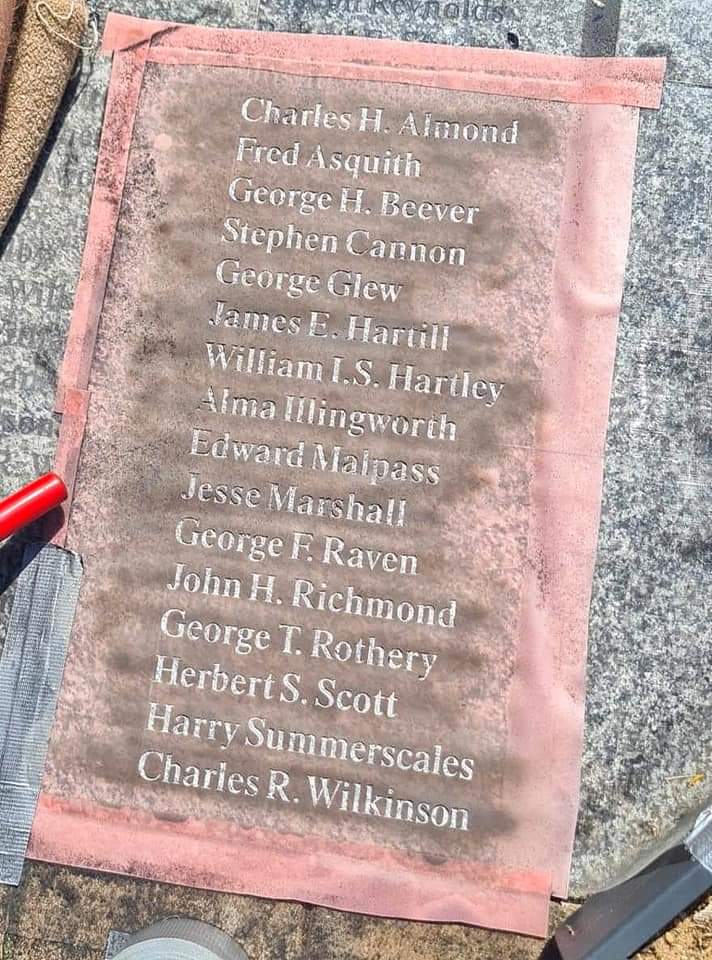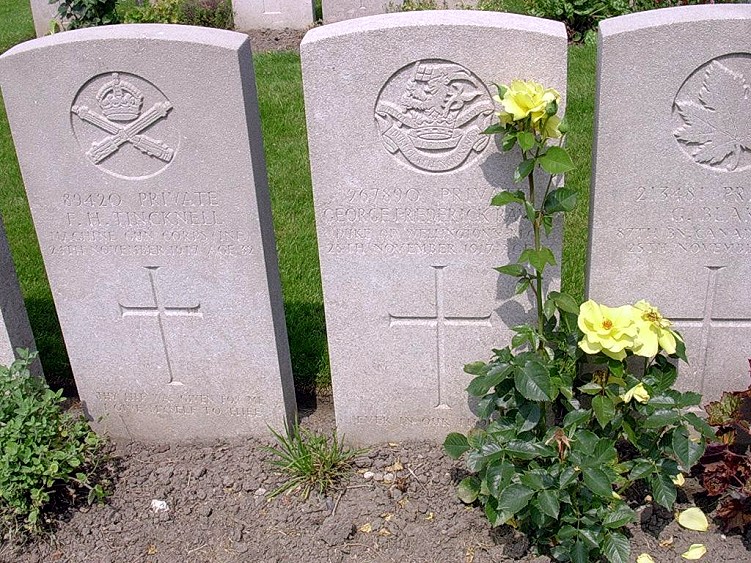
In 2022, the names of an additional 22 of Ossett's Fallen were quietly added to the surroundings of the Ossett War Memorial by Wakefield Council. One of those names was George Frederick Raven. After taking a more detailed look at George I discovered that he wasn't the only one in the Raven household to pay the ultimate price during WW1. Tragedy hit this family hard with the additional premature deaths of his brother Charlie and their sister Dorothy, who both died as a result of the 1918-1920 influenza pandemic.

These further studies have revealed that at least four out of the six Raven brothers served in the First World War, whilst their only sister Dorothy worked as a 'munitionette', supplying troops at the front with armaments and equipment. Another brother, Fred, didn't survive infancy and died at the age of 5½ months in April 1886. All the siblings were born in Barnsley but for a few short years they lived at Ryecroft Street, Ossett with their parents, John and Emma.
Emma Elvin of Market Rasen and Norfolk born John William Raven were married on March 18 1884 at the bride's parish church. John had joined the police force on November 13 1882 and, after serving his probationary period in Wakefield, he was sent to Barnsley where he remained until 1896. He was then transferred to Eccleshill, remaining there until November 1899. From there he was transferred to the Dewsbury area and was stationed at Ossett until 1903 when he was transferred to the Halifax Division. When he retired on New Year's Eve 1907 John William Raven had served as a police officer for 25 years. He was later a member of the First Reserve, and in 1914 he resumed active duty, for a short time guarding waterworks at Denshaw, Saddleworth.
John William Raven was born on December 10 1886 and baptised at St Mary's on June 19 the following year. He was almost 13 when he moved to Ryecroft Street with his family and was 16 when they moved to Brighouse. In 1911 he was living with his brother Harry and his family in Manchester and was working as a mechanical engineer. On April 27 1914 he married Eliza Jane Broomhead at Halifax Parish Church and they moved into 14 Richard Street, Brighouse - the house Eliza had previously shared with her sister.
On December 9 1915, the day before his 29th birthday, John William Raven swore an oath to serve his King and Country and enlisted with the Reserves. He attested on October 27 1916 and served with the 17th (Prince of Wales's Own) West Yorkshire Regiment and attained the rank of Sergeant. His military medical document recorded his civilian occupation as that of temporary postman. It also recorded that Sgt John William Raven 301651 was 5ft 7½ and weighed 139lbs.
On May 16 1918 John signed a declaration to say that he had received his Military Medal, awarded for bringing in wounded under heavy fire. On November 19 1917, notice of his bravery appeared in The Gazette, the newsletter that reported on official War Office and Ministry of Defence events. John survived the war but was still in France when he was demobilised on December 22 1919.
In 1946 there was a notice in the Halifax Evening Courier celebrating John's award of the Imperial Service Medal (ISM) in recognition of his 25 year long service in the Civil Service. He had held a supervising rank at Brighouse Post Office and was also the Chair of the Post Office Workers Union, prior to which he had been union secretary for 12 years. Not such a temporary postman after all … I don't know when John passed away.
James Alfred Raven was born on June 8 1888 and baptised on August 29 at St Mary's. He lived at Ryecroft Street, Ossett from the age of 11 until he was 14. After the family moved to Brighouse, James took a job at a brick works. He married 26 year old Lily Haynes on August 16 1913 at St Matthew's in Rastrick. They lived in Brighouse and James worked for a millwright. They had two children: a daughter, Constance, who was born on August 21 1914 and a son, Norman, who was born on July 8 1917.
During WWl James was in a reserved occupation and therefore exempt from military service. A 1929 newspaper reported that he had been fined for the brakes not working on his motorcycle. The report revealed that James was a blacksmith's striker, probably at the millwright's.
During WWll James volunteered with the Air Raid Precautions rescue and demolition team. Almost all ARP wardens were part-timers who came on duty after they finished their day's work. James was still working at a millwrights - this would have been an engineering repair shop, attending to breakdowns, repairing and maintaining machinery used in the many different mills. In later years the family moved to Scotland, with the exception of Constance who married motor salesman Thomas R Lunn and emigrated to Canada. James died in 1967.
Bruce Harold Raven was born on February 1 1890 and baptised at St Mary's on April 9. He lived at Ryecroft Street, Ossett from the age of nine until the age 13. On December 7 1913 Bruce married 25 year old Lois Wakefield at St James's, Thornes. Lois lived at 24 Ings Cottages, Denby Dale Road, Wakefield and worked in a hotel. Evidence suggests that this was The Foresters Arms at Durkar where Bruce lived and was employed to drive a wagonette. Their daughter Irene was born in July 1915 but died when she was just 11 months old.
On October 10 1916 Bruce enlisted with the 25th Battalion Durham Light Infantry before becoming a Sapper with the Royal Engineers Railway Troops Department. Bruce survived the war and was discharged on February 12 1919, returning to his home at White House, Hall Cliffe, Horbury.
He was declared no longer fit for active duty and was awarded the Silver War Badge. This was issued to UK service personnel who had been honourably discharged due to wounds or sickness. Records state that he suffered from epilepsy as well as having a problem with his eyesight. He had been issued glasses at the Leeds General Infirmary in January 1917; I suppose it's no coincidence that their son Jack was born in Horbury nine months later. A daughter Minnie was born in Horbury on April 5 1920 and a third daughter, Joan, was born three years later.
After the war Bruce was employed by the Horbury Urban District Council as a horseman. During WWll he was a special constable. Across the whole of the UK, during the Second World War, the regular police force was supplemented by a volunteer police force: the Special Constabulary. Those who volunteered were mainly veterans of earlier wars and others whose age or position in a reserved occupation prevented them from enlisting.
During WWll their son Jack was employed at Charles Roberts and Co. Ltd at Horbury Bridge. Minnie worked at Leather Products at Westfield Road, Horbury. During WWll Leather Products switched from making their usual sports goods to providing uniforms for service personnel. Charles Roberts were renowned as builders of railway wagons and as railway wagon repairers. Throughout WWII they constantly adapted and many of the products they built were used in the D-Day Landings. They also produced munitions and were credited with creating the nation's 'millionth bomb'. My own grandmother, Phyllis Fawcett (née Davies), worked in Charles Roberts munitions department.
Lois Raven née Wakefield died in 1950 and in the spring of 1955 Bruce Harold Raven married Mary A Davis. Bruce died in 1968.

Charlie attained the rank of Serjeant with the (Prince of Wales's Own) West Yorkshire Regiment. Twice he was wounded but it was pneumonia, contracted on active service, that eventually killed him. He was 25 years old when he died at 26th General Hospital in Étaples, France on June 19 1918. He is buried at Plot LXVI. F. 2. at Étaples Military Cemetery, France.
Although the name of Charlie's brother George was added at the Ossett War Memorial in 2022, Charlie wasn't afforded the same honour until the following year.

Dorothy May Raven, the only daughter out of eight children, was born on September 19 1896 and, just like her brothers, baptised at St Mary's, Barnsley. By the age of 14 Dorothy was employed as a silk spinner. During WWl Dorothy worked in a munitions factory in Brighouse where she daily risked her life to supply the armed services with ammunition. A now fairly well known phenomenon was the TNT poisoning which turned many women’s skin yellow. But the Canary Girls, as they became known, didn't just suffer with a change in skin colour. TNT poisoning also meant coughs, chest infections, digestive problems and ultimately could kill.
When I learned that Dorothy had died at home at Smithy Carr Lane, Brighouse on the particularly poignant date of November 11 1918 (Armistice Day), I sent off for her death certificate to see what had caused her premature death. 22 year old Dorothy had tragically succumbed to the flu pandemic that swept the globe during WW1. The same sickness that killed Dorothy had also killed her brother Charlie.

On May 30 1921, at St Martin's Church, Brighouse, the town turned out to witness the unveiling of a memorial window and a tablet (both paid for by public subscription) to the memory of 49 men connected with the church, who were killed in WW1. Among those names were those of brothers Charlie Raven and George Frederick Raven. The two brothers are also named on the Brighouse War Memorial and at the Ossett War Memorial.
There is no memorial for Dorothy May Raven.

When we remember the service personnel who laid down their lives, let us also remember those whose names have been forgotten, those who remained at home and also gave their all.

